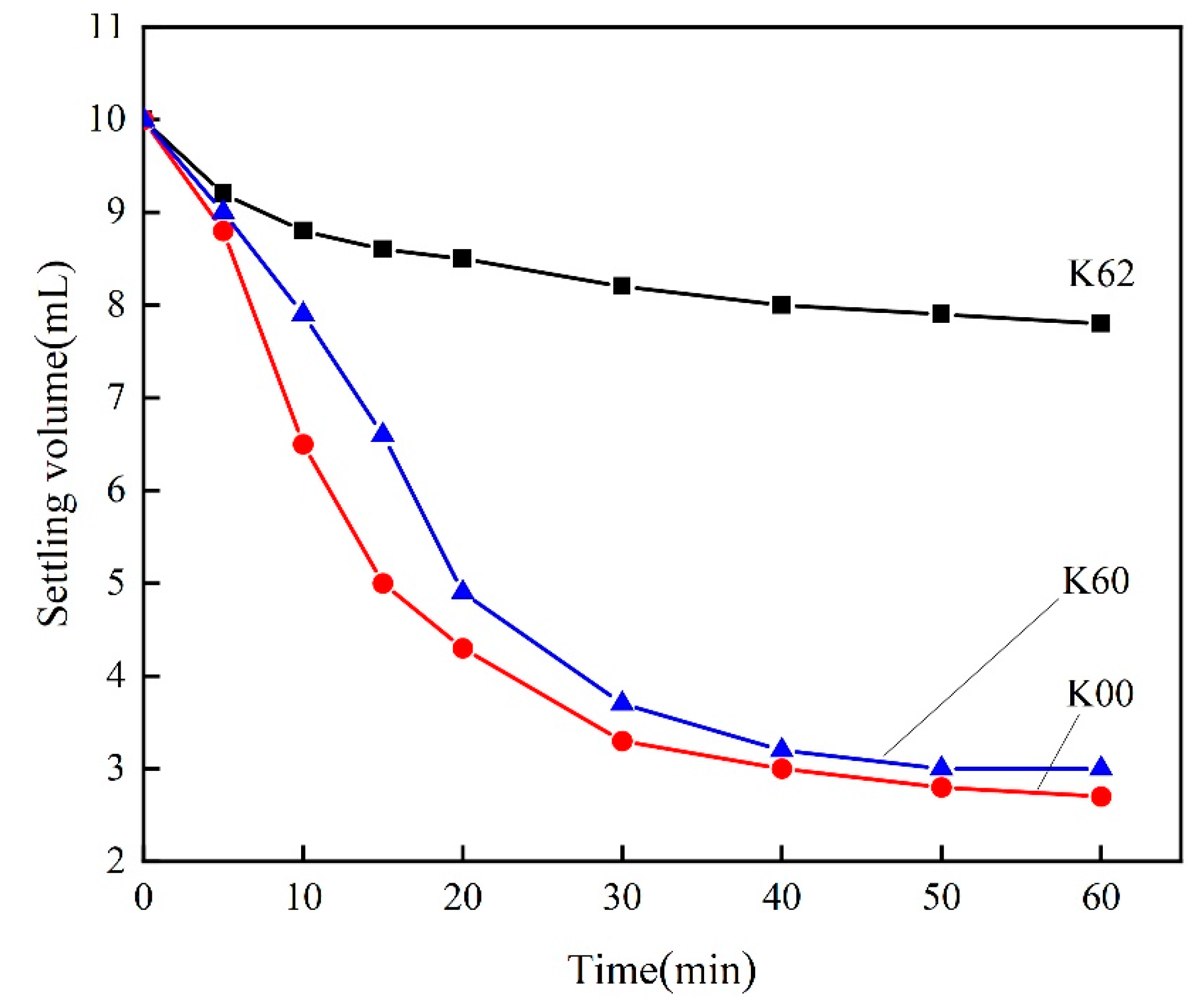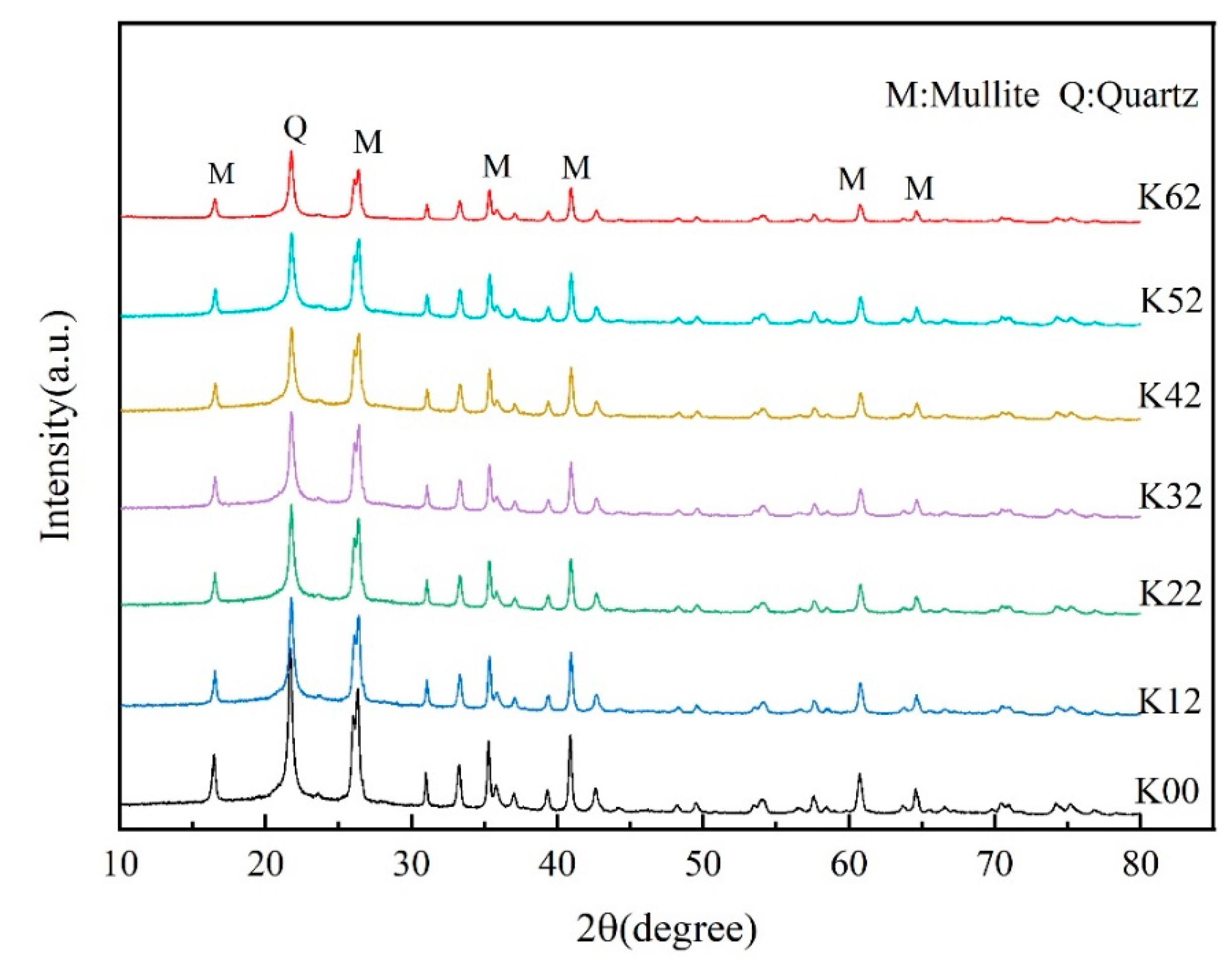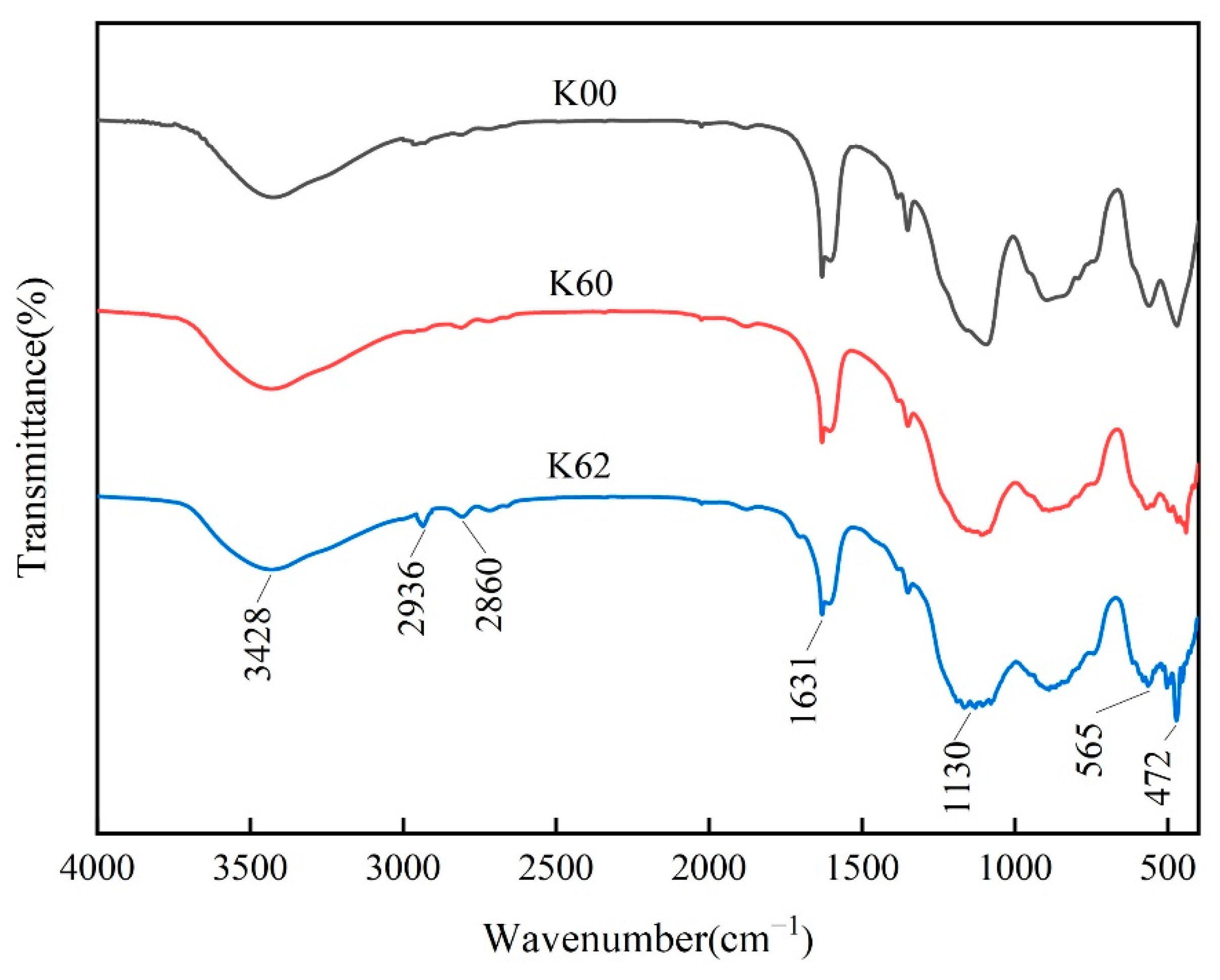Preparation and Characterization of Modified Kaolin by a Mechanochemical Method
Abstract
:1. Introduction
2. Experimental Procedure
2.1. Materials
2.2. Preparation of Sample
2.3. Dispersivity Experiments
2.4. Adsorption Experiments
2.5. Characterization of Samples
3. Results and Discussion
3.1. Changes in Particle Size
3.2. Particle Size Distribution
3.3. Changes in Specific Surface Area
3.4. Dispersion Ability Test
3.5. Adsorption Performance Test
3.6. Microstructure
3.6.1. XRD Analysis
3.6.2. SEM Analysis
3.6.3. FT-IR Analysis
4. Conclusions
Author Contributions
Funding
Institutional Review Board Statement
Informed Consent Statement
Data Availability Statement
Conflicts of Interest
References
- Wei, B.; Wu, X.; Liu, Z.; Peng, C.; Li, K. Research on the development status of the foreign kaolin industry. China Non-Met. Miner. Ind. Guide 2019, 3, 52–55. [Google Scholar]
- Yang, S.; Yuan, P.; He, H.; Qin, Z.; Zhou, Q.; Zhu, J.; Liu, D. Effect of reaction temperature on grafting of gamma-aminopropyl triethoxysilane onto kaolinite. Appl. Clay Sci. 2012, 63, 8–14. [Google Scholar] [CrossRef]
- Xu, H.; Wang, M.; Liu, Q.; Wang, H.; Zhang, H.; Yang, K. Study of coal-based kaolin/dimethyl sulfoxide intercalation composites. J. Funct. Mater. 2010, 41, 620–622. [Google Scholar]
- Detellier, C.; Schoonheydt, R.A. From Platy Kaolinite to Nanorolls. Elements 2014, 10, 201–206. [Google Scholar] [CrossRef]
- Ekosse, G. Provenance of the Kgwakgwe kaolin deposit in Southeastern Botswana and its possible utilization. Appl. Clay Sci. 2001, 20, 137–152. [Google Scholar] [CrossRef]
- Ekosse, G. The Makoro kaolin deposit, southeastern Botswana: Its genesis and possible industrial applications. Appl. Clay Sci. 2000, 16, 301–320. [Google Scholar] [CrossRef]
- Balaz, P.; Achimovicova, M.; Balaz, M.; Billik, P.; Cherkezova-Zheleva, Z.; Criado, J.M.; Delogu, F.; Dutkova, E.; Gaffet, E.; Gotor, F.J. Hallmarks of mechanochemistry: From nanoparticles to technology. Chem. Soc. Rev. 2013, 42, 7571–7637. [Google Scholar] [CrossRef] [Green Version]
- Fu, M.; Li, Y.; Wu, S.; Lu, P.; Liu, J.; Dong, F. Sol-gel preparation and enhanced photocatalytic performance of Cu-doped ZnO nanoparticles. Appl. Surf. Sci. 2011, 258, 1587–1591. [Google Scholar] [CrossRef]
- Krishna, B.S.; Murty, D.; Prakash, B. Thermodynamics of chromium(VI) anionic species sorption onto surfactant-modified montmorillonite clay. J. Colloid Interf. Sci. 2000, 229, 230–236. [Google Scholar] [CrossRef]
- Bailey, S.E.; Olin, T.J.; Bricka, R.M.; Adrian, D.D. A review of potentially low-cost sorbents for heavy metals. Water Res. 1999, 33, 2469–2479. [Google Scholar] [CrossRef]
- Bhattacharyya, K.G.; Sen Gupta, S. Removal of Cu(II) by natural and acid-activated clays: An insight of adsorption isotherm, kinetic and thermodynamics. Desalination 2011, 272, 66–75. [Google Scholar] [CrossRef]
- Nguetnkam, J.P.; Kamga, R.; Villieras, F.; Ekodeck, G.E.; Razafitianamaharavo, A.; Yvon, J. Alteration of cameroonian clays under acid treatment. Comparison with industrial adsorbents. Appl. Clay Sci. 2011, 52, 122–132. [Google Scholar] [CrossRef]
- Belver, C.; Bañares Munoz, M.A.; Vicente, M.A. Chemical activation of a kaolinite under acid and alkaline conditions. Chem. Mater. 2002, 14, 2033–2043. [Google Scholar] [CrossRef]
- Lima, P.E.A.; Angelica, R.S.; Neves, R.F. Dissolution kinetics of metakaolin in sulfuric acid: Comparison between heterogeneous and homogeneous reaction methods. Appl. Clay Sci. 2014, 89, 159–162. [Google Scholar] [CrossRef]
- Gao, Z.; Li, X.; Wu, H.; Zhao, S.; Deligeer, W.; Asuha, S. Magnetic modification of acid-activated kaolin: Synthesis, characterization, and adsorptive properties. Micropor. Mesopor. Mater. 2015, 202, 1–7. [Google Scholar] [CrossRef]
- Zhang, J.; Zhang, P.; Cheng, F. Effect of Unhydrated Aminopropyl Triethoxysilane Modification on the Properties of Calcined Kaolin. Minerals 2022, 12, 705. [Google Scholar] [CrossRef]
- Unuabonah, E.I.; Olu-Owolabi, B.I.; Adebowale, K.O.; Ofomaja, A.E. Adsorption of lead and cadmium ions from aqueous solutions by tripolyphosphate-impregnated Kaolinite clay. Colloids Surf. 2007, 292, 202–211. [Google Scholar] [CrossRef]
- Unuabonah, E.I.; Adebowale, K.O.; Olu-Owolabi, B.I.; Yang, L.Z.; Kong, L.X. Adsorption of Pb(II) and Cd(II) from aqueous solutions onto sodium tetraborate-modified Kaolinite clay: Equilibrium and thermodynamic studies. Hydrometallurgy 2008, 93, 1–9. [Google Scholar] [CrossRef]
- Unuabonah, E.I.; Adebowale, K.O.; Olu-Owolabi, B.I. Kinetic and thermodynamic studies of the adsorption of lead (II) ions onto phosphate-modified kaolinite clay. J. Hazard. Mater. 2007, 144, 386–395. [Google Scholar] [CrossRef]
- Colina, F.G.; Caballero, I. Reaction between kaolin and sulfuric acid at high temperature. Design of a plant-scale reactor. Sili-Cates Ind. 2006, 71, 205–212. [Google Scholar]
- Steudel, A.; Batenburg, L.F.; Fischer, H.R.; Weidler, P.G.; Emmerich, K. Alteration of non-swelling clay minerals and magadiite by acid activation. Appl. Clay Sci. 2009, 44, 95–104. [Google Scholar] [CrossRef]
- Lin, H.; Dong, Y. Coating mechanism of nano-TiO2 films on the surface of ultra-fine calcined coal kaolin particles. Int. J. Min. Met. Mater. 2011, 18, 487–493. [Google Scholar] [CrossRef]
- Yuan, Y.; Chen, H.; Lin, J.; Ji, Y. Surface modification of calcined kaolin with toluene diisocyanate based on high energy ball milling. Appl. Surf. Sci. 2013, 284, 214–221. [Google Scholar] [CrossRef]
- He, K.; Chen, G.; Zeng, G.; Chen, A.; Huang, Z.; Shi, J.; Peng, M.; Huang, T.; Hu, L. Enhanced removal performance for methylene blue by kaolin with graphene oxide modification. J. Taiwan Inst. Chem. E 2018, 89, 77–85. [Google Scholar] [CrossRef]
- Zhang, X.; Liu, H.; Xing, H.; Li, H.; Hu, H.; Li, A.; Yao, H. Improved sodium adsorption by modified kaolinite at high temperature using intercalation-exfoliation method. Fuel 2017, 191, 198–203. [Google Scholar] [CrossRef]
- Sakr, A.K.; Al-Hamarneh, I.F.; Gomaa, H.; Abdel Aal, M.M.; Hanfi, M.Y.; Sayyed, M.I.; Khandaler, M.U.; Cheira, M.F. Removal of uranium from nuclear effluent using regenerated bleaching earth steeped in β-naphthol. Radiat. Phys. Chem. 2022, 200, 110–204. [Google Scholar] [CrossRef]
- Belachew, N.; Hinsene, H. Preparation of cationic surfactant-modified kaolin for enhanced adsorption of hexavalent chromium from aqueous solution. Appl. Water Sci. 2020, 10, 1–3. [Google Scholar] [CrossRef] [Green Version]
- Pakade, V.E.; Tavengwa, N.T.; Madikizela, L.M. Recent advances in hexavalent chromium removal from aqueous solutions by adsorptive methods. Rsc Adv. 2019, 9, 26142–26164. [Google Scholar] [CrossRef] [PubMed] [Green Version]
- Shaban, M.; Sayed, M.I.; Shahien, M.G.; Abukhadra, M.R.; Ahmed, Z.M. Adsorption behavior of inorganic- and organic-modified kaolinite for Congo red dye from water, kinetic modeling, and equilibrium studies. J. Sol-Gel Sci. Technol. 2018, 87, 427–441. [Google Scholar] [CrossRef]
- De Faria, E.H.; Ciuffi, K.J.; Nassar, E.J.; Vicente, M.A.; Trujillano, R.; Calefi, P.S. Novel reactive amino-compound: Tris(hydroxymethyl)aminomethane covalently grafted on kaolinite. Appl. Clay Sci. 2010, 48, 516–521. [Google Scholar] [CrossRef]
- Lu, D.; Tang, Z.; Zhang, L.; Zhou, J.; Gong, Y.; Tian, Y.; Zhong, J. Effects of Combined Usage of Supplementary Cementitious Materials on the Thermal Properties and Microstructure of High-Performance Concrete at High Temperatures. Materials 2020, 13, 1833. [Google Scholar] [CrossRef] [PubMed] [Green Version]
- Dadsetan, S.; Siad, H.; Lachemi, M.; Sahmaran, M. Extensive evaluation on the effect of glass powder on the rheology, strength, and microstructure of metakaolin-based geopolymer binders. Constr. Build Mater. 2021, 268, 121168. [Google Scholar] [CrossRef]
- Liu, X.; Zhao, S. Measurement of the condensation temperature of nanosilica powder organically modified by a silane coupling agent and its effect evaluation. J. Appl. Polym. Sci. 2008, 108, 3038–3045. [Google Scholar] [CrossRef]
- Xu, G.; Xu, G.; Chang, W.; Wang, H. Fabrication of microsphere-like nano-MoO2 modified with silane coupling agent KH-550. Mater. Res. Express 2019, 6, 1–11. [Google Scholar] [CrossRef]
- Singh, P.; Singh, I.B.; Mondal, D.P. A comparative study on compressive deformation and corrosion behaviour of heat treated Ti4wt%Al foam of different porosity made of milled and unmilled powders. Mater. Sci. Eng. C-Mater. Biol. Appl. 2019, 98, 918–929. [Google Scholar] [CrossRef] [PubMed]
- Cheng, Q.; Chen, J.; Yi, G.; Shan, Y.; Geng, Y.; Wang, J.; Wang, W. Comparative study of the microstructure and phase evolution of FeCoCrNiAl high-entropy alloy-matrix WC nanocomposite powders prepared by mechanical alloying. J. Alloys Compd. 2023, 938, 1–10. [Google Scholar] [CrossRef]
- Li, Z. Mechanochemical Modification of Bentonite and Its Adsorption Properties. Master’s Thesis, Nanjing University of Technology, Nanjing, China, 2006. [Google Scholar]
- Fang, W.; Tu, Y.; Yan, J.; Yao, C.; Zhang, J.; Sheng, J. Study on superhydrophobic modified pyrophyllite by a mechanochemical method. Nonmet. Ore 2011, 34, 23–25. [Google Scholar]
- Rubio-Hernandez, F.; Paez-Flor, N.; Gomez-Merino, A.; Sanchez-Luque, F.; Delgado-Garcia, R.; Goyos-Perez, L. The influence of high-concentration Na hexametaphosphate dispersant on the rheological behavior of aqueous kaolin dispersions. Clays Clay Miner. 2016, 64, 210–219. [Google Scholar] [CrossRef]
- Konduri, M.K.R.; Fatehi, P. Dispersion of kaolin particles with carboxymethylated xylan. Appl. Clay Sci. 2017, 137, 183–191. [Google Scholar] [CrossRef]
- Xu, J.; Yang, W.; Niu, L.; Dan, X.; Wang, C.; Wen, C. Study on the surface modification of Sb2O3 nanoparticles by using mechanochemical method. Inorg. Nano-Met. Chem. 2017, 47, 697–702. [Google Scholar] [CrossRef]
- Zhang, X.; Xia, B.; Ding, B.; Zhang, Y.; Luo, J.; Jiang, B. Ultra-fast surface hydrophobic modification of sol-gel silica antireflective coating with enhanced abrasion-resistance. Mater. Lett. 2013, 104, 31–33. [Google Scholar] [CrossRef]
- Padalkar, K.V.; Gaikar, V.G.; Aswal, V.K. Characterization of mixed micelles of sodium cumene sulfonate with sodium dodecyl sulfate and cetyl trimethylammonium bromide by SANS, FTIR spectroscopy and NMR spectroscopy. J. Mol. Liq. 2009, 144, 40–49. [Google Scholar] [CrossRef]
- Cheng, H.; Zhang, S.; Liu, Q.; Li, X.; Frost, R.L. The molecular structure of kaolinite-potassium acetate intercalation complexes: A combined experimental and molecular dynamic simulation study. Appl. Clay Sci. 2015, 116, 273–280. [Google Scholar] [CrossRef]
- Neubert, P.; Behr, A. Applied Homogeneous Catalysis; Wiley-VCH: Weinheim, Germany, 2012; pp. 352–361. [Google Scholar]









| Composition | Al2O3 | SiO2 | P2O5 | SO3 | K2O | CaO | TiO2 | Fe2O3 | Others |
|---|---|---|---|---|---|---|---|---|---|
| Content(wt.%) | 47.38 | 50.71 | 0.03 | 0.02 | 0.15 | 0.20 | 0.87 | 0.59 | 0.05 |
Disclaimer/Publisher’s Note: The statements, opinions and data contained in all publications are solely those of the individual author(s) and contributor(s) and not of MDPI and/or the editor(s). MDPI and/or the editor(s) disclaim responsibility for any injury to people or property resulting from any ideas, methods, instructions or products referred to in the content. |
© 2023 by the authors. Licensee MDPI, Basel, Switzerland. This article is an open access article distributed under the terms and conditions of the Creative Commons Attribution (CC BY) license (https://creativecommons.org/licenses/by/4.0/).
Share and Cite
Liang, X.; Li, Q.; Fang, Y. Preparation and Characterization of Modified Kaolin by a Mechanochemical Method. Materials 2023, 16, 3099. https://doi.org/10.3390/ma16083099
Liang X, Li Q, Fang Y. Preparation and Characterization of Modified Kaolin by a Mechanochemical Method. Materials. 2023; 16(8):3099. https://doi.org/10.3390/ma16083099
Chicago/Turabian StyleLiang, Xiulin, Qiang Li, and Ying Fang. 2023. "Preparation and Characterization of Modified Kaolin by a Mechanochemical Method" Materials 16, no. 8: 3099. https://doi.org/10.3390/ma16083099




